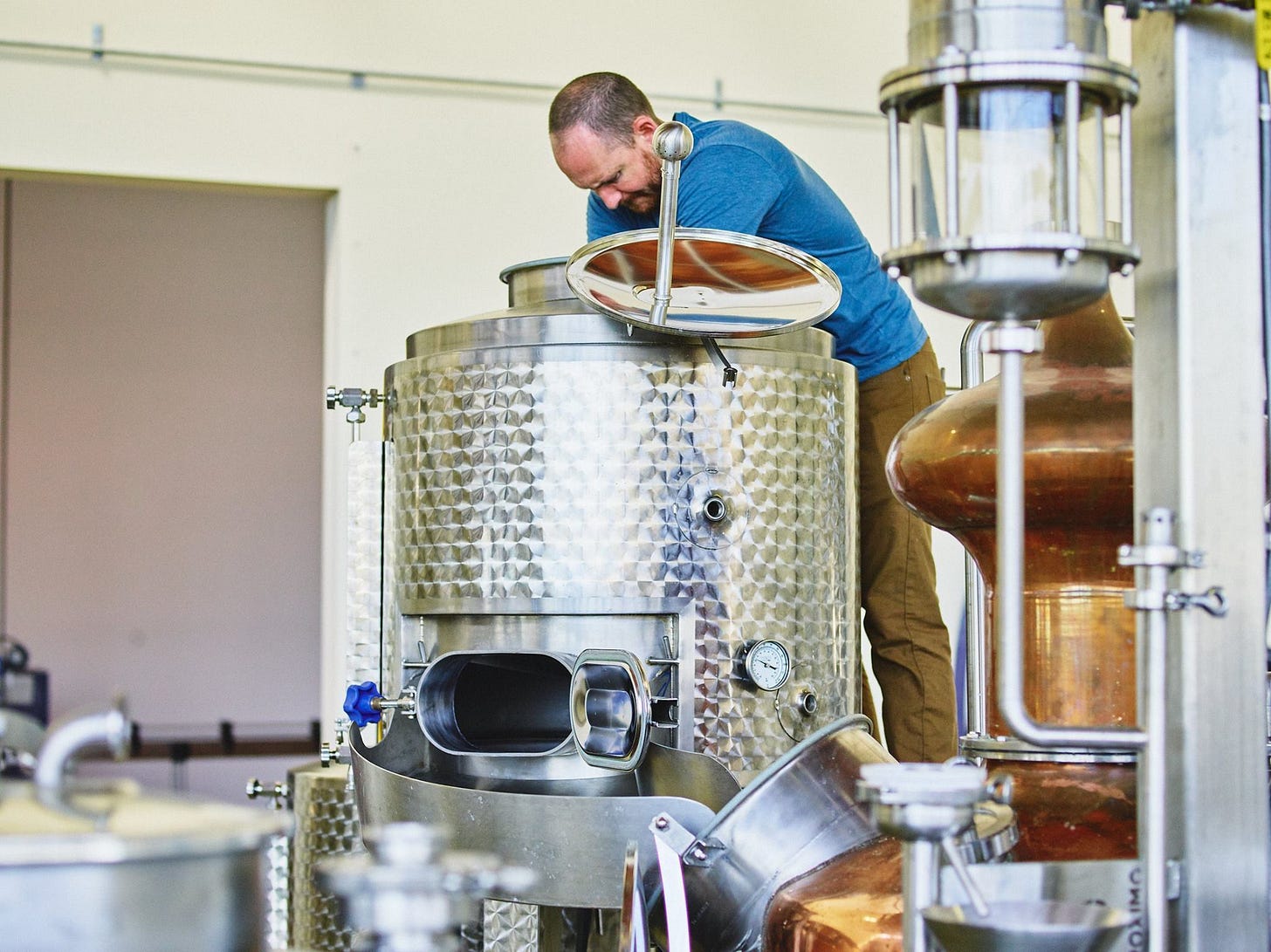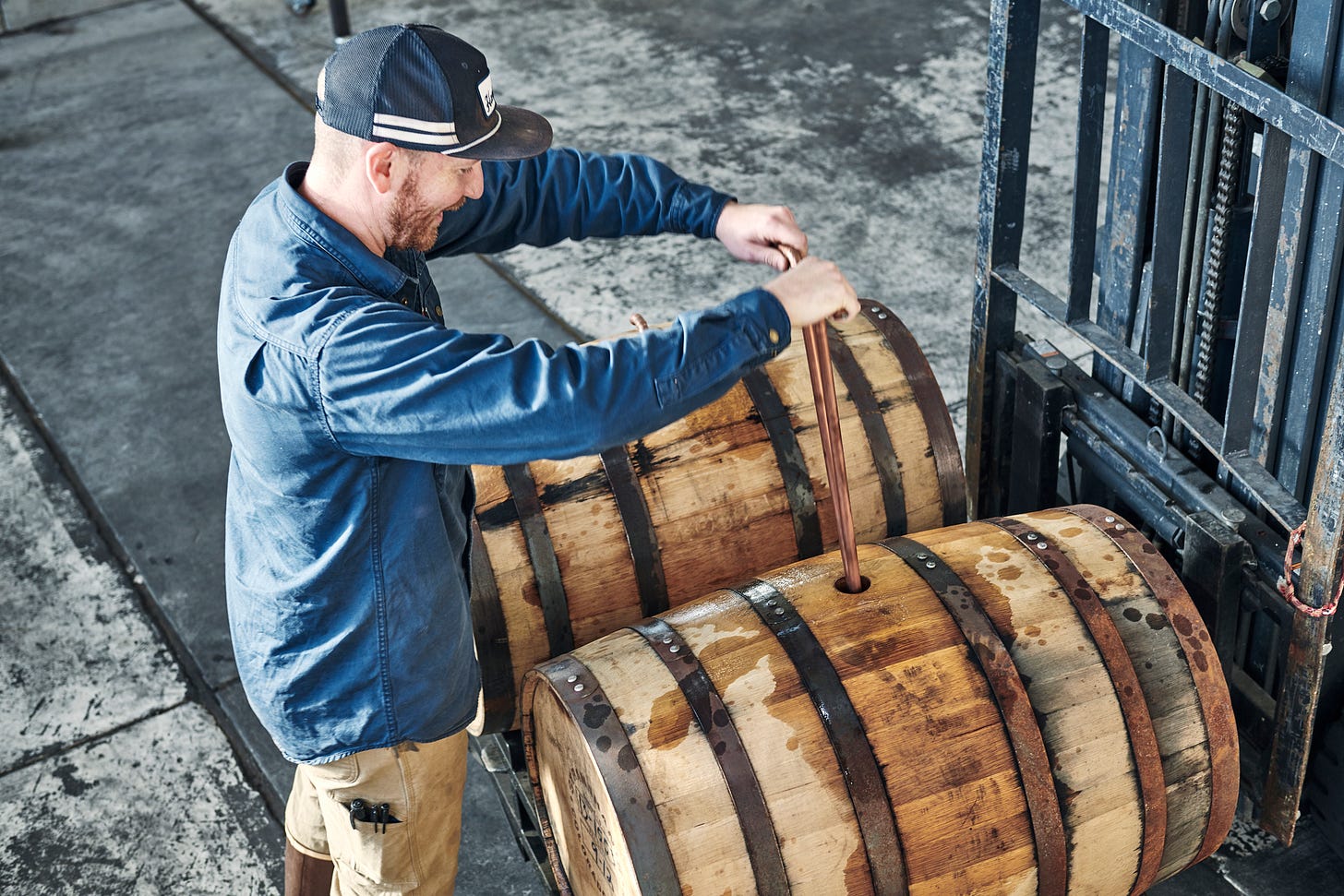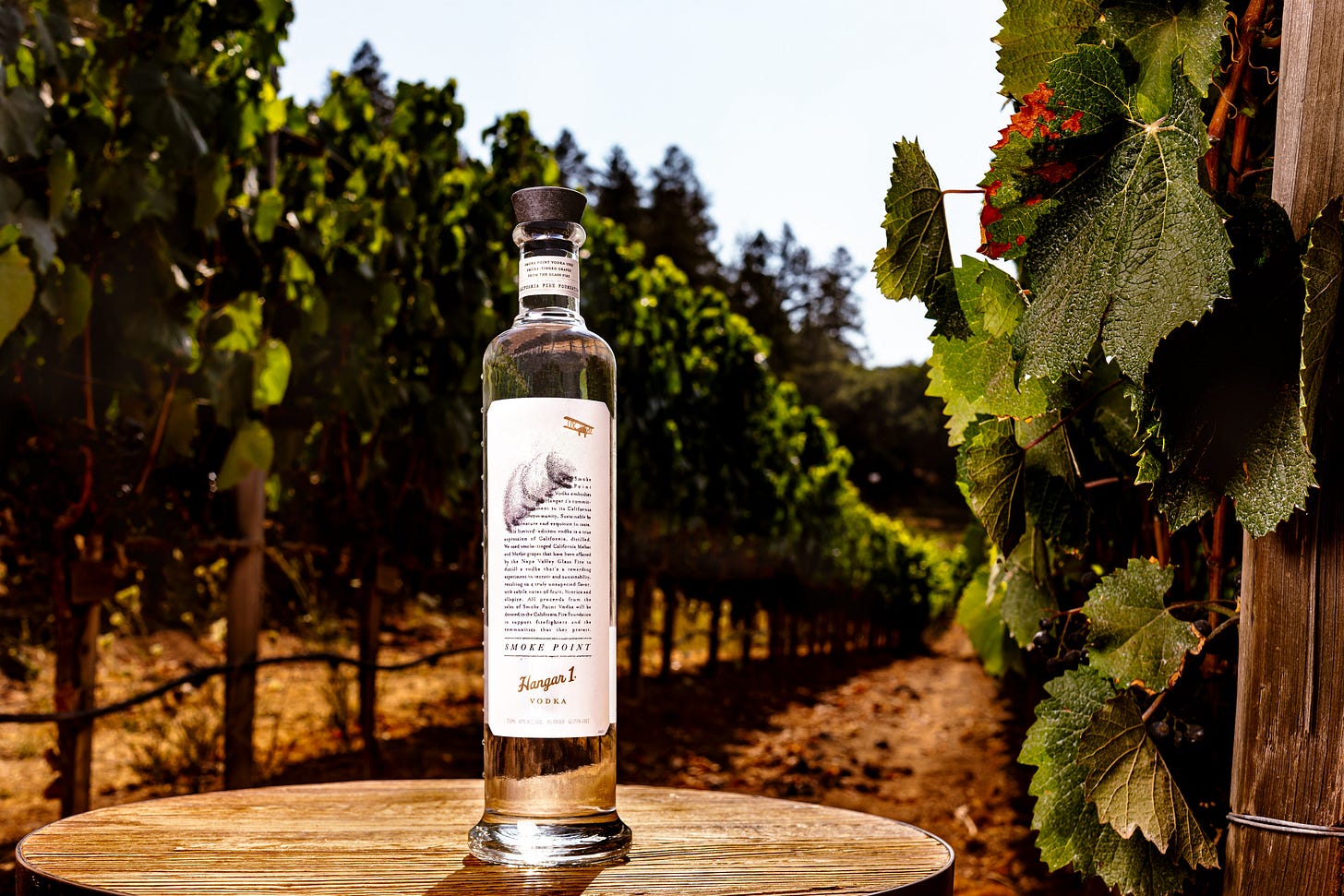The Fizz #36: Distiller Eric Lee at Hangar 1 is making vodka from smoke-tainted grapes
Hangar 1's Eric Lee is giving back to the California Fire Fund through an experimental distillation of smoke-tainted grapes, and learning about the unique flavors different grapes bring to vodka.
Hey subscribers. Thanks for giving me the space to take a week off last week—there was no issue last week, and it’s because I’m a person who gets tired and sometimes needs to take a break. This week, we’re back with an interview with distiller Eric Lee at Hangar 1 Vodka. This interview was incredible for my novice understanding of how spirits are made, and how they stand out with unique flavors, but it also showed me just how connected the beverage industry really is—whether it’s wine or spirit focused.
Hangar 1 Vodka isn’t new to making grape-based vodka, but they are new to smoke taint. When the wildfire season of 2020 took out many California vineyards’ grapes and/or introduced smoke taint to otherwise delicious juice, they thought about a way to help spread awareness around how wildfires were affecting their grape growing neighbors. Eric and his team got to work accruing smoke tainted wine from their neighbors at Crimson Wine Group, and distilling it into what is now Smoke Point Vodka, with all proceeds going to the California Fire Foundation. In this interview, we talk about the process, the meaning, and the vision behind Smoke Point.
Margot: Can you tell me about how you got started at Hangar 1 and what you do there?
Eric: I'm a distiller at Hangar 1. I got my start in distilling a few years ago at what used to be Anchor Distilling Company, making whiskey and gin, but now I'm here at Hangar 1 making vodka.
Margot: Awesome. Do you mostly make vodka? Is there anything else that y'all make?
Eric: Right now we are really focused on just vodka.
Margot: As a Russian, vodka is definitely part of my culture, so I love to see folks specializing in that spirit. How did you decide to make this product from smoke affected grapes?
Eric: Last year there were some pretty massive fires going on here in California. A lot of wineries and vineyards were being affected, and some unfortunately burned down, but the vast majority of what happened was the smoke was settling onto the skins of the grapes. Further down the winemaking process, those grapes get harvested, the juice gets squeezed, and there's fermentation. Often, the taste of smoke carries over into those wines. What was happening was affecting tons of vineyards, tons of winemakers, and our friends at the Crimson Wine Group who we've worked with previously on other wine based vodkas—they were among those affected.
They were doing their lab tests for quality assurance on those grapes, which were testing positive for smoke compounds, the phenols that settle onto the skins of the grapes. Sometimes that smokey character in wine doesn't really carry over right away—it's not detectable right away. It's usually much further down the process. Typically, it could be right after fermentation, or even one to three years later that the smoke character comes up. They decided that smokey flavor wasn't something that they wanted and chose not to continue on with the winemaking process. They hadn’t gone through malolactic fermentation, they hadn't done barrel maturations. This was basically just fermented juice and they decided that they didn't want it.
We were curious about what was going to happen if you distill that into a vodka, because we've worked wine into vodka previously, most previously with our Fog Point, a blend of a grain-based spirit and grape based spirit. We're very familiar with using wine as a base material, but we were curious, how smokey was this wine and then what would happen if you distilled it? When we got the wine into the hangar, it didn't taste of smoke, and that was to be expected. You know, sometimes that smoke molecule, it binds to the sugars and then it doesn't get fully released until way later.
So the wine tasted amazing. Well, it was just fermented juice. I wouldn't call it a finished wine by any stretch. We were curious about whether the distillation would reveal a smoke character. We did some experiments, and it turns out that the smoke character does not come across, especially in a vodka distillation. Since we distilled to such a high proof in a relatively high purity of spirit—at the end result, no smoke character is coming through. What we did get was a wonderful wine based vodka.
There’s a similar characteristic for grape and wine based vodkas. I would say there's a nice soft roundness, a richness compared to something like wheat or corn or even some rye based vodkas. Grain-based is a little bit cleaner, a little bit more neutral. With a grape based vodka, there is something about the fruit skins or the oils that come through, which makes for a full bodied, very rich vodka.
Margot: That's really cool. So what happens to that guaiacol? It just disappears?
Eric: That's the thing with distillation. It's not really a chemical reaction. It's more of a physical separation of the two liquids. You have wine, which is mostly water, alcohol, and then a bunch of other stuff, you know, particulates—there's pieces of grape skin there's the yeast that's left over.
When you do these vodka distillations, you're able to very much separate the alcohol and the little bit of water. That's basically what you get, and there's a very, very thin margin of other compounds that come through. We call them congeners, but that's where vodka flavor comes from. It's a very narrow band of these compounds that can distill alongside ethanol. Guaiacol and other phenols, they don't really come across. They're a little too heavy of molecules to come through.
Margot: Interesting. So there are some particulates or phenols that add to the flavor, and that’s why they’re distinct vodkas?
Eric: Well, if you're trying to get a smoke character in a spirit, you'd have, for instance, a mezcal or a peated scotch, where they’re deliberately adding smoke and roasting their raw materials. Those distillations aren't to as high a proof as vodka. They're not as pure, but they're not trying to be as pure because they want those flavors to carry through the distillation.
Margot: Gotcha. Okay. That makes sense. So then what adds that heavier mouthfeel, and the different flavors in vodkas?
Eric: When you have vodka distilled to, by legal requirement, 95% alcohol coming off the still, or 190 proof, that other 5% is water and things that sorta can be distilled in parallel with ethanol. The balance of those remaining compounds, those congeners, that is how you can differentiate vodka made from rain versus vodka made from grapes or whatever base material are you are working with. It's a very thin narrow band of these materials that come across, but that’s how it happens with the different materials you start with.
Margot: Okay, so there are different congeners in grapes than there are in rye or potato or grain?
Eric: Maybe they’re the same, but they're in different proportions to one another.
Margot: Okay, cool. That's really interesting. Thank you for explaining that to me. When you got together with Crimson Wine Group, did you buy that juice from them? Or did they just give it to you?
Eric: It wasn’t purchased. Legally, they couldn't donate it, but it's all part of a larger donation that we made that we made to the California Fire Foundation. Because of the alcohol laws, California doesn’t allow for direct donation. There was no money exchanged—it was all part of a larger program to raise money for CFF.
Margot: Gotcha. So they donated this juice that you distilled, and now you’re donating back all of the proceeds to the California Fire Foundation—and that’s all the sales, not just the profits.
Eric: That’s right.
Margot: And that was juice that they were just going to eat anyway, right?
Eric: Yeah. The unfortunate circumstance for a lot of wineries and vineyards was, for the vineyards, either not harvesting the grapes or for the wineries, they harvest them and then it turns out that smoke has affected the wine and they can't sell it and it gets dumped down the drain. So either way it’s not great. We have an opportunity to turn it around. How can we take something that was going to just be dumped or left to rot and make something positive out of it, showcase what is normally extremely high quality wine, and bring more attention to the seriousness, the gravity of the fires happening here in California and seemingly every year. That fire season gets longer and longer.
Margot: It’s super scary. If a winemaker came to you and said, you know, I have this juice, there's nothing I can really do with it. Would you be open to distilling this for me, would you do that sort of thing?
Eric: If it's something that makes sense in a partnership that would be great for everyone involved then yeah. It's not something we would rule out. When we do a release like Smoke Point, we need a certain amount of wine to make the whole thing work. It can’t just be a super tiny winery that only makes a couple hundred cases because it wouldn’t be enough wine for us.
Margot: That makes sense. Where have you gotten grapes in the past that you've worked with?
Eric: We've worked directly with Crimson Wine Group, and two years prior to that, we were using wine from Bonny Doon down in Santa Cruz. We've done some experiments in house with some other things that haven't really seen the light of day with some more Central Valley wines as well.
Margot: Gotcha. So you started this out as an experiment, obviously it went really well. What happens now, are you going to keep doing this? Are you going to reach out to other growers or wineries? What’s in your future?
Eric: That is unclear. You know, the fire seasons are a little bit unpredictable. We don't want to really have to make this product in the future because it's not a wonderful circumstance. What we really want to do is just raise awareness for how fragile it all is. We’re trying to bring light to the communities that are being really affected, and we want to give back and show thanks to the firefighters that are really the heroes of what's going on.
Margot: Absolutely. I love that. There's a real sustainability focus here too. I’ve talked to a lot of wine makers who, either they have to let their fruit drop so they can collect insurance, and some growers don't have insurance and they're truly screwed. A lot of winemakers are just like, wow, this product is just going to compost, what a bummer. We could make something else out of this. It's great to see that you’re picking up on that. Have you learned anything through the process of distilling vodka from smoke tainted wine?
Eric: What we've been figuring out along the way is that there are very minute differences between the grape varietals, in terms of the spirit we collect at the end. Our previous experience most recently was Five Point, and for that, we use a blend of Chenin Blanc and Viognier grapes. We taste and sample and test vodka pretty regularly, so we have a pretty fine-tuned palate for vodka, and it was very different from what we distilled for Smoke Point, which was a blend of Napa Valley Malbec and Merlot.
It's a difference of red wine versus white wine, and the different varietals therein. It was pretty surprising how distinct the spirit character is.
Margot: That’s amazing. What was that difference?
Eric: It's tough to put into words. If you had a side-by-side comparison, it makes it a little bit more obvious, but, the white wines we've worked with previously are a little bit higher acidity or a little bit brighter, a little bit more citrus-y fruity, whereas the red wines we're working with, the balance of flavors is a little bit different. That carries across in the spirit, and not in a direct one-to-one sort of way, but you sorta see the base material—the essence of it come through.
Margot: There is kind of like an element of terroir here, then?
Eric: Absolutely. Yeah.
Margot: That's really cool. Would you do this again?
Eric: You know, distilling is the best part of the job, especially when it's something new and exciting and we can really showcase the area that we live in and the agricultural products that come from here—which for us is a lot of wine. It’s awesome to have great neighbors who are super easy to work with and making great stuff. It makes it a lot easier to make a great spirit because distilling’s not magic. If you have good ingredients going in, you're going to get a good spirit coming out.
We really want to bring attention to the seriousness and the intensity of the fire season and how it's really affecting all of us. It's not just a handful of regions. It's really the whole state.
Margot: How is that donation working? How much money do you think you’ll be able to raise?
Erik: There are about 4800 bottles, 800 six packs is what we’ve yielded out of the wine we got. At about $50 a bottle, we’ll hopefully be able to make a big donation.
Margot: That’s awesome. Well, I appreciate seeing folks like you think about that sustainability aspect in a creative way. Thank you for your time today!
————
You can support Hangar Wine in their donation by buying a bottle of the Smoke Point vodka, available in many California liquor stores. I tried a sample, and it was delicious and super smooth. Follow Hangar 1 on Instagram and show your support for their charitable initiative. If you want to donate to California Fire Foundation directly, you can do that here.
Did you like this issue? Hit subscribe below and for $5/month, you’ll get these exclusive interviews and tasting note posts on local wines. You’ll also be helping me record more information about exciting winemakers, American history, and help me pay my interviewees who aren’t making wine for their own label. 15% goes to St. Francis House.






